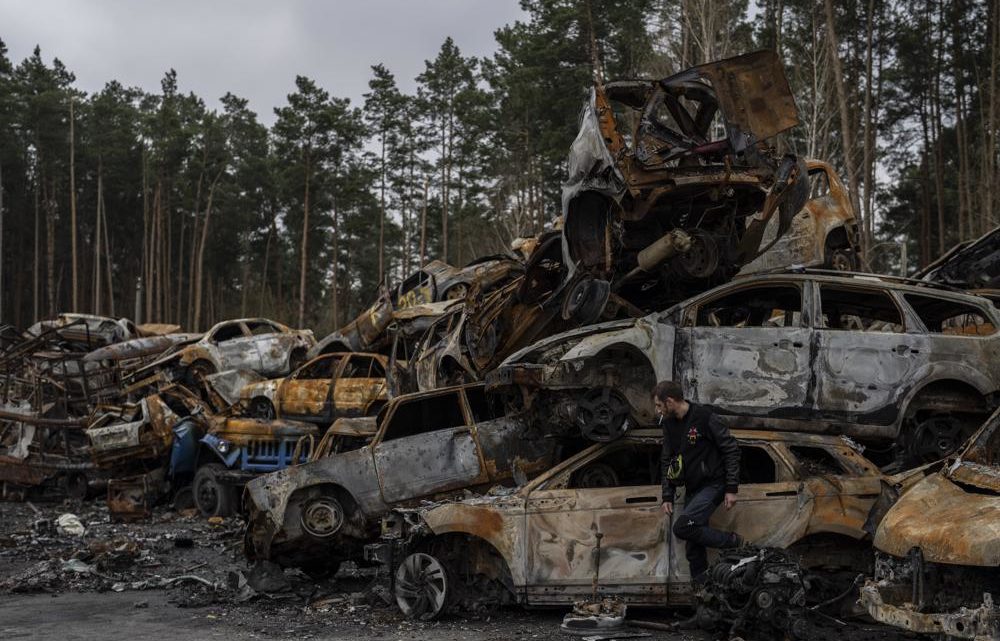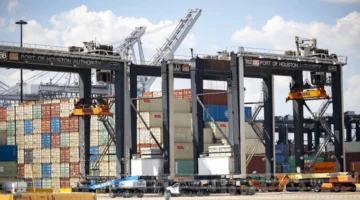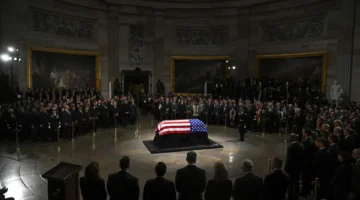Satellite photos show possible mass graves near Mariupol
By ADAM SCHRECK
A man walks next a storage place for burned vehicles in Irpin, on the outskirts of Kyiv, Thursday, April 21, 2022. (AP Photo/Petros Giannakouris)
KYIV, Ukraine (AP) — Satellite images released Thursday showed what appeared to be mass graves near Mariupol, and local officials accused Russia of burying up to 9,000 Ukrainian civilians there in an effort to conceal the slaughter taking place in the siege of the port city.
The images emerged hours after Russian President Vladimir Putin claimed victory in the battle for the Mariupol, despite the presence of an estimated 2,000 Ukrainian fighters who were still holed up at a giant steel mill. Putin ordered his troops not to storm the stronghold but to seal it off “so that not even a fly comes through.”
Satellite image provider Maxar Technologies released the photos, which it said showed more than 200 mass graves in a town where Ukrainian officials say the Russians have been burying Mariupol residents killed in the fighting. The imagery showed long rows of graves stretching away from an existing cemetery in the town of Manhush, outside Mariupol.
Mariupol Mayor Vadym Boychenko accused the Russians of “hiding their military crimes” by taking the bodies of civilians from the city and burying them in Manhush.
The graves could hold as many as 9,000 dead, the Mariupol City Council said Thursday in a post on the Telegram messaging app.
Boychenko labeled Russian actions in the city as “the new Babi Yar,” a reference to the site of multiple Nazi massacres in which nearly 34,000 Ukrainian Jews were killed in 1941.
“The bodies of the dead were being brought by the truckload and actually simply being dumped in mounds,” an aide to Boychenko, Piotr Andryushchenko, said on Telegram.
There was no immediate reaction from the Kremlin. When mass graves and hundreds of dead civilians were discovered in Bucha and other towns around Kyiv after Russian troops retreated, Russian officials denied that their soldiers had killed any civilians there and accused Ukraine of staging the atrocities.
In a statement, Maxar said a review of previous images indicates that the graves in Manhush were dug in late March and expanded over the past couple of weeks.
After nearly two lethal months of bombardment that largely reduced Mariupol to a smoking ruin, Russian forces appear to control the rest of the strategic southern city, including its vital but now badly damaged port.
But a few thousand Ukrainian troops, by Moscow’s estimate, have stubbornly held out for weeks at the steel plant, despite a pummeling from Russian forces and repeated demands for their surrender. About 1,000 civilians were also trapped there, according to Ukrainian officials.
Instead of sending troops to finish off the defenders in a potentially bloody frontal assault, Russia apparently intends to maintain the siege and wait for the fighters to surrender when they run out of food or ammunition.
Boychenko rejected any notion that Mariupol had fallen into Russian hands.
“The city was, is and remains Ukrainian,” he declared. “Today our brave warriors, our heroes, are defending our city.”
The capture of Mariupol would represent the Kremlin’s biggest victory yet of the war in Ukraine. It would help Moscow secure more of the coastline, complete a land bridge between Russia and the Crimean Peninsula, which Russia seized in 2014, and free up more forces to join the larger and potentially more consequential battle now underway for Ukraine’s eastern industrial heartland, the Donbas.
Putin expressed concern for the lives of Russian troops in deciding against sending them in to clear out the sprawling Azovstal steel plant, where the die-hard defenders were hiding in a maze of underground passageways.
At a joint appearance with Russian Defense Minister Sergei Shoigu, Putin declared, “The completion of combat work to liberate Mariupol is a success,” and he offered congratulations to Shoigu.
Shoigu predicted the steel plant could be taken in three to four days, but Putin said that would be “pointless.”
“There is no need to climb into these catacombs and crawl underground through these industrial facilities,” the Russian leader said. “Block off this industrial area so that not even a fly comes through.”
The plant covers 11 square kilometers (4 square miles) and is threaded with some 24 kilometers (15 miles) of tunnels and bunkers.
“The Russian agenda now is not to capture these really difficult places where the Ukrainians can hold out in the urban centers, but to try and capture territory and also to encircle the Ukrainian forces and declare a huge victory,” retired British Rear Adm. Chris Parry said.
Russian officials for weeks have said capturing the mostly Russian-speaking Donbas is the war’s main objective. Moscow’s forces opened the new phase of the fighting this week along a 300-mile (480-kilometer) front from the northeastern city of Kharkiv to the Azov Sea.
While Russia continued heavy air and artillery attacks in those areas, it did not appear to gain any significant ground over the past few days, according to military analysts, who said Moscow’s forces were still ramping up the offensive.
A senior U.S. defense official, speaking on condition of anonymity to discuss the Pentagon’s assessment, said the Ukrainians were hindering the Russian effort to push south from Izyum.
Rockets struck a neighborhood of Kharkiv on Thursday, and at least two civilians were burned to death in their car. A school and a residential building were also hit, and firefighters tried to put out a blaze and search for anyone trapped.
Elsewhere, Ukrainian Deputy Prime Minister Iryna Vereshchuk said Russian troops kidnapped a local official heading up a humanitarian convoy in the southern Kherson region. She said the Russians offered to free him in exchange for Russian prisoners of war, but she characterized that as unacceptable.
Vereshchuk also said efforts to establish three humanitarian corridors in the Kherson region failed Thursday because Russian troops did not hold their fire.
Western nations, meanwhile, rushed to pour heavy weapons into Ukraine to help it counter the offensive in the east.
U.S. President Joe Biden announced an additional $800 million in military assistance, including heavy artillery, 144,000 rounds of ammunition and drones. But he also warned that the $13.6 billion approved last month by Congress for military and humanitarian aid is “almost exhausted” and more will be needed.
All told, more than 100,000 people were believed trapped with little or no food, water, heat or medicine in Mariupol, which had a prewar population of about 430,000. Over 20,000 people have been killed in the siege, according to Ukrainian authorities.
The city has seized worldwide attention as the scene of some of the worst suffering of the war, including deadly airstrikes on a maternity hospital and a theater.
Ukraine has repeatedly accused Russia of launching attacks to block civilian evacuations from the city. On Thursday, at least two Russian attacks hit the city of Zaporizhzhia, a way station for people fleeing Mariupol. No one was wounded, the regional governor said.
Britain’s Defense Ministry said that Russia probably wants to demonstrate significant successes ahead of Victory Day on May 9, the proudest day on the Russian calendar, marking the defeat of Nazi Germany in World War II.
“This could affect how quickly and forcefully they attempt to conduct operations in the run-up to this date,” the ministry said.
In other developments, Ukrainian President Volodymyr Zelenskyy warned Ukrainians living in areas of southern Ukraine under Russian control not to provide Russians with their IDs, which he said could be used “to falsify a so-called referendum on our land” to create a Moscow-friendly government.
“This is a real possibility,” he said in his nightly video address to the nation. “Beware.”






No Comment